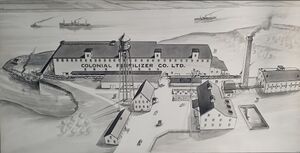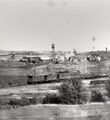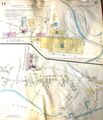Dominion Atlantic Railway Digital Preservation Initiative - Wiki
Use of this site is subject to our Terms & Conditions.
Colonial Fertilizer
Colonial Fertilizer Company, Windsor
- Nesbitt Street, Windsor, east of the Windsor Wear textile plant
- Mile 0.65 2345-foot long spur from the Truro Subdivision
History

The plant in Windsor began in 1885 with Robert Pigeon and Nicholas Mosher producing “Eureka” brand fertilizer. Mosher died in 1887 and the firm continued as the Pigeon Fertilizer Company. The plan was bought in 1912 by the Consolidate Rendering Company of Boston (later known as Corenco). They changed the name to the Colonial Fertilizer Company and expanded the plant, adding a hide business, the Colonial Hide Company.[1] The company came to encompass a large complex of sheds and warehouses built around a wharf on the St. Croix River where the Tregothic Creek created a sheltered inlet. The facility included a 2345-foot long spur from Mile .65 on the DAR’s Midland branch which served a long loading bay from the main plant building and continued to a double track spur on the Colonial Fertilizer wharf.
The plant generated large amounts of seasonal railway traffic which peaked in the fertilizer season from March to May.[2] Large shipments sometimes required the daily assistance of an extra switcher engine sent from Kentville.[3] as well as special fertilizer trains to Windsor and Digby [4] and extra trips of the SS Princess Helene taking fertilizer to New Brunswick and Maine customers.[5] Fertilizer shipments by ship continued into the 1960s.
The company was sold to Canada Packers in 1960 which also owned the Shur-Gain feed and fertilizer operation in Port Williams. In the 1970s, operations at the Windsor Plant were transferred to the Port Williams plant and Colonial Fertilizer closed. [6] Little trace remains of the plant today, aside from the ruins of the silted-up dock, although traces of the beginning of the spur may be seen at the old Midland roadbed.
Gallery
Panoramic photo of workers at the Colonial Fertilizer Plant at loading dock with a Pere Marquette boxcar, 1920.
DAR locomotive No. 556 watering at the Windsor Water Tower with the Windsor Wear textile factory and the Colonial Fertilizer Plant, circa 1920s.
Detail of Fort Edward view with the Colonial Fertilizer plant in the background and a construction train with a pile driver and MOW cars No. 859, formerly No.52 Baggage and No. 872, No. 36 Coach, circa 1920s.
Windsor tracks with Colonial Fertilizer plant in background and a MOW cars No. 859 and No. 872 on siding of the Midland/Truro Subdivision, circa mid 1930s.
Windsor Fire Insurance Map, Sheet 11, showing Colonial Fertilizer, the Windsor Baggage Station, Windsor Railyard, Windsor Wharves and the Windsor Wear Textile Factory, July 1941.
Engraving showing an artists impression of the Colonial Fertilizer and Colonial Hides Plants, circa 1950.
Survey plan of Halifax Subdivision tracks, structures, and right-of-way through Windsor, including details of the Colonial Fertilizer plant structures and tracks, January 1955.
Dominion Atlantic Rail Liner passes water tower, Windsor with the Windsor Wear Textile Plant to the left and the Colonial Fertilizer plant to the right, Aug. 1961.
References and Footnotes
- ↑ Gwendolyn Vaughan Shand, ‘’Historic Hants Country’’, (1979), pages 156 and Gary W. Ness, The Dominion Atlantic Railway: 1894-1994, (2014), page 86.
- ↑ George Bishop, ”Railway Notes”, The Advertiser|’’The Advertiser’’ Feb. 18, 1937, May 26, 1938
- ↑ Gary W. Ness, The Dominion Atlantic Railway: 1894-1994, (2014), page 86 and George Bishop, ”Railway Notes”, The Advertiser May 6, 1937
- ↑ George Bishop, ”Railway Notes”, The Advertiser May 12, 1938
- ↑ George Bishop, ”Railway Notes”, The Advertiser , May 6, 1937
- ↑ Gwendolyn Vaughan Shand, ‘’Historic Hants Country’’, (1979) pages 157.
External Links
Ray Prevost, Facebook Post and Discussion, Dec. 20, 2021
Facebook Post, "The Colonial Fertilizer Co.", The Story of Pisiquid: Land of Plenty, April 21, 2023






